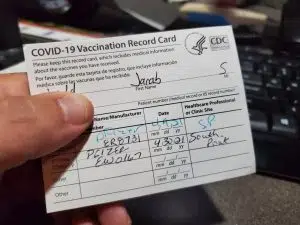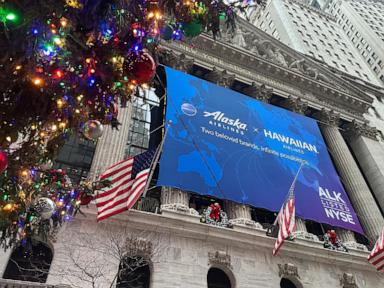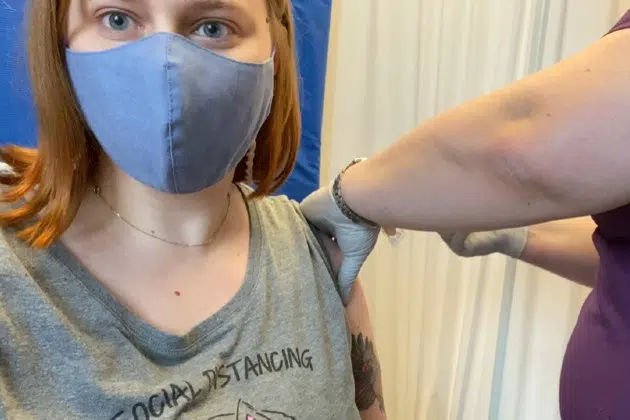(KNSI) – Less than two weeks after the state of Minnesota opened up COVID-19 vaccine eligibility to all residents 16 and older, all three members of the KNSI newsroom got their shots. We received our doses at three separate locations and, funnily enough, each received different COVID-19 vaccines.
KNSI has reported on the COVID-19 pandemic since the first cases were confirmed in the area, and throughout the year, we’ve covered November’s case spike and the resulting tightening of restrictions across the state, how local businesses have been impacted by the pandemic and how Minnesota’s vaccination rollout started as a small, targeted effort to a system that has inoculated nearly half of the state’s residents so far. Here are our COVID-19 vaccine stories.
News Director Jennifer Lewerenz:
Update: I did cry. The nurse was wonderful. Thanks #dollyparton and all of the special people who made this possible for everyone. #teammoderna #COVID19 #vaccine #vaccinated https://t.co/ClLtewlwuW pic.twitter.com/K6PLRvnBAK
— Jennifer Lewerenz (@HeyJLev) April 7, 2021
When COVID-19 started to appear on our radar in January, it was in the back of my mind as a news junkie. I thought, “It’s China, but it’s something to keep an eye on.”
Then it came to the U.S. The alerts went out to wash your hands, don’t touch your face, here are the symptoms to be aware of. After that, I was more cognizant of washing my hands and how often I really did touch my face. When eating, I was conscientious about making sure I could taste anything I ate because I already don’t like being sick, and from what the national news was telling us, this COVID-19 coronavirus is a doozy.
In late February, my husband and I went to Fort Meyers for Minnesota Twins spring training. I wasn’t super worried about coronavirus. Again, COVID-19 was in the back of my mind, especially when the gentleman behind us on the plane was coughing and sneezing and drooling and slobbering within two feet of us for the entire three-hour flight home.
A few days after we returned, the coronavirus-related death toll in the U.S. was six. Eight days later, the World Health Organization declared COVID-19 a global pandemic. In the days following, everything came to a screeching halt.
Bars, restaurants, gyms, churches, schools, stores and pretty much everything else closed. Sports seasons were canceled, Easter mass was canceled, the State Fair was canceled. We were told to stay inside unless we absolutely needed to leave. Toilet paper, cleaning products and hand sanitizer seemed to be the new currency. I sat at home with a stomach ache, bewildered, repeatedly asking no one in particular, “What is going on? What even is this?” I missed my mom and dad. I missed my grandma. People I knew got sick and died. People I knew lost their jobs and livelihoods. It sucked.
I could not wait to roll up my sleeve if it meant getting to do normal stuff again, but I was happy to wait my turn.
Then a few months went by, and the Centers for Disease Control started talking about a vaccine in clinical trials, but it wasn’t going to be ready for 12 to 18 months. Cases and deaths were down, only to go back up as soon as we headed inside for the winter. It seemed as though we would hear notes of hope, only to be plunged back into the grim reality that coronavirus would be here for a while yet.
The day after Joe Biden was declared President-Elect, it was suddenly announced that the U.S. had a vaccine! What timing! I could not wait to roll up my sleeve if it meant getting to do normal stuff again, but I was happy to wait my turn.
My mom, my dad and my grandma all had gotten fully vaccinated. It was like a burden had been lifted that I didn’t have to worry about them as much anymore. My grandma is 95, and Mom and Dad both have underlying health conditions that could make them more susceptible to contracting coronavirus, and worse, dying from it.
At the beginning of April, I was contacted by the Minnesota Department of Health, saying I could make an appointment for a vaccine. I was so excited. I can’t form the proper words to explain it.
BAM! Number two! #CovidVaccine #COVID19 #rollupyoursleeves #GotMyShot pic.twitter.com/30bhN7Z2bC
— Jennifer Lewerenz (@HeyJLev) May 6, 2021
I got my date and time, and as I stood in line to get my shot, I started to get very emotional. I was just so overjoyed at the promise and hope this offered people who had been stuck inside away from their families and the elderly who had been so isolated and probably scared they were next; I was absolutely overcome.
When people heard that I had gotten my shot, here came the horror stories of so-and-so who got so sick they were in bed for a week after their shot. So-and-so got a big bruise on their arm after they got their shot. I thought, “What have I done.”
Then came the arm soreness. My right arm from shoulder to elbow was pretty much useless for three days; it hurt so much.
Roughly two weeks later, I got sick. Coughing, sore throat, mild fever and the like. I thought, “Here we go. I’m going to be the one who gets COVID after my vaccination.” But I got tested, and it wasn’t. Not sure what it was, but it was very COVID-like from those I know who had it.
When it came time for my second shot, which I had also heard story after story of illnesses and ailments following. I went in thinking that whatever was going to happen was going to happen. Still, I figured in the long run it was better to be vaccinated.
I was just so overjoyed at the promise and hope this offered people who had been stuck inside away from their families and the elderly who had been so isolated and probably scared they were next.
As soon as I got my shot and was able to leave, I popped two Tylenol when I got to my car and kept up the regular Tylenol popping for the next day or two, and by the time I boarded a plane bound for an out-of-town wedding two days later, I had no ill side effects whatsoever. No arm pain, no headache, no fever, nothing.
Now that the mask mandate has been lifted, it’s so lovely to see your smiles. It’s beautiful to see kids and parents laughing together at church, restaurants and stores. It’s more indescribably joyful than getting my first vaccination.
Please keep smiling. Whether you continue to wear a mask or go maskless, please keep smiling. It was a dark 14 months. We deserve smiles, and even more, we deserve to see them on others’ faces.
______________________________________________
Reporter/anchor Dene Dryden:
I received the one-dose Johnson & Johnson vaccine on April 7th, just over a week after I became eligible. My husband and I both scheduled our vaccine appointments on that first day of expanded eligibility, a moment that felt like a stroke of luck.
(Don’t look if you don’t like needles)
One and done! So happy to get the J&J COVID vaccine today 🥰 pic.twitter.com/H3PhWSHcSF
— Dené K. Dryden (@denekdryden) April 7, 2021
In March 2020, I was living in Kansas, finishing up my last semester of college and getting ready for my March 20th wedding. You know what comes next. We postponed our wedding, my classes went online and we stocked up on face masks, hand sanitizer and toilet paper. Through the summer, I worked at my college’s radio station to cover news about the pandemic, the Black Lives Matter movement and other goings-on in Manhattan, Kansas. My husband and I rescheduled our wedding for August 7th; we wed outside the county courthouse surrounded by our parents, siblings and one photographer. A week later, we drove up to St. Cloud so I could interview for the open reporting position at KNSI. By the end of August, we were moving to Minnesota.
On my wedding day, I had no idea what the next few months would bring for COVID, my career path or just about anything else. Exactly eight months later, I was sitting in a chair in Paynesville’s CentraCare clinic receiving my COVID vaccine.
I’m happy to say that I was part of the majority of vaccine recipients who had just mild symptoms after receiving my shot. A few hours after I got the vaccine, I started to feel soreness in my arm and neck. The next day, I was a little more tired than usual, but I was able to go about my usual routine without any issues. Two days after, I felt completely fine.
I’m happy to say that I was part of the majority of vaccine recipients who had just mild symptoms after receiving my shot.
I got the J&J shot a few days before the U.S. paused administration of that vaccine due to reports of blood clots in women between the ages of 18 and 49 who had recently received it. As a person in that demographic, I looked at the data — there is a more than a one in a million chance to develop this side effect. In the three weeks after I got my vaccine, I heeded Dr. Mike Varshavski’s phrase “alert, not anxious:” I informed myself on what the warning signs are for a cerebral venous sinus thrombosis blood clot and kept tabs on my mental health to make sure I wasn’t becoming overly worried about that rare risk.
The idea of getting vaccinated against this disease was so exciting. In November, my mom and my two younger sisters caught COVID-19, and I was afraid that I, like so many other people across the globe, would lose a family member to COVID. Thankfully, they recovered, and my mom and 20-year-old sister (who both work at an elementary school) got vaccinated with the Moderna vaccine in February. Most of my immediate family members and in-laws are now at least partially vaccinated, which opened the opportunity for my husband and me to visit family and friends in Kansas in late May.
Happy to report that Kyle has now gotten his COVID vaccine. ☺️ We got scheduled at different clinics, and we ended up getting different vaccines. Maybe we should get one of those “house divided” license plates, but instead of KU/K-State, it’s Janssen/Pfizer
— Dené K. Dryden (@denekdryden) April 7, 2021
As someone who has been reporting on the pandemic for over a year, I trust the COVID vaccine I received and the two others that are available, which are highly effective at preventing COVID infection in the real-world studies we now have access to. If you don’t take it from me, take it from my mom: She tells me that after having mild symptoms after both of her vaccine doses, those side effects are much, much better than actually catching COVID. Each vaccine dose, to me, represents one piece of a huge puzzle that depicts our post-pandemic future. In January, with so few pieces in the puzzle, it was hard to see what that future would look like or how soon it would arrive. Now with more than half of the pieces matched and more liberal guidance on what fully vaccinated people can do without masks, we’re getting a clearer picture.
It’s time to end the pandemic in Minnesota, the U.S. and around the globe. The way to do that is for each of us to do our part and get vaccinated.
______________________________________________
Reporter/anchor Jake Judd:

Jake Judd
The first time I heard of the coronavirus was in January of 2020. I remember the virus being described as a new type of pneumonia, and I didn’t give it much thought. I assumed the virus would have the same effects on my life as the SARS outbreak in 2003, swine flu in 2009 or the Ebola crisis in 2014. I had worked through them without any significant disruptions and had no reason to think this would be any different. How wrong I was.
As January moved into February, I began to note that this wasn’t like the other diseases that made news in the past. I watched closely as my daughters, wife, and myself prepared to visit my parents in Flordia. Getting to the airport that evening was, for the most part, ordinary. A handful of people were wearing masks and using hand sanitizer. It was February 28, 2020, and it’s the last time I’ve been on vacation or on an airplane.
When we arrived in Florida, there were no cases in the state or back home in Minnesota. There were only a handful of cases reported in a few states. The next day, I remember hearing about the first death in the United States attributed to COVID-19 in Washington state. Over the week, while enjoying the sun and family fun, I watched as a handful of states with positive cases exploded with cases in almost every state, including Flordia, and back home in Minnesota.
It was around then I realized this was something new. Watching Youtube memes on the coronavirus suddenly wasn’t so funny. It started to feel like an impending wave was racing towards us, and I didn’t know if I would be able to get out of the way.
On the last day of our trip, my family went to Disney’s Animal Kingdom, and people were still acting normal. Little did I know I would be one of the last to visit the park because it would close a week later.
My mind changed about the vaccine a year after the pandemic started.
On Wednesday, March 11, 2020, when I got back home from a late dinner with the family, the President took to the airwaves and announced a travel ban to Europe. I knew it was only a matter of time before the pandemic would hit my community, and nowhere was immune from the virus.
I didn’t have to wait long.
The next day, I was preparing a story for that weekend’s St. Patrick’s Day Parade in St. Cloud when KNSI received word that Stearns County had its first case of the COVID-19. After that, the pandemic became a nonstop avalanche of chaos as bars, restaurants, nonessential stores, and services closed because of executive orders meant to slow the spread and keep the health care system from getting overrun.
We’ve all had to deal with some form of distance learning or communication, working from home, limited contact with others, the loss of social and religious activities, and it’s taken its toll on everyone. The phrase Zoom call wasn’t in my vocabulary two years ago. Now it’s an everyday thing. As the world stopped, hope emerged as labs across the country and the world started working on a vaccine.
The first shots started to go into the public’s arms in December 2020 and January 2021, with health care workers, frontline workers and the most vulnerable up first.
I admit: I was hesitant and didn’t want to be in the first wave of vaccine recipients because of the fear of the unknown. It’s new, and anything new can be scary.
My mind changed about the vaccine a year after the pandemic started. It was early April of 2021, and the state was experiencing a surge of COVID cases being driven by variants. It was around that time I learned that the patients being treated for COVID-19 in St. Cloud Hospital weren’t the older victims seen in the early part of the pandemic. Most were under the age of 65. At that point, most people age 65 and older in Stearns County had received a vaccine, and that was enough proof for me that the vaccine works.
I called my clinic and scheduled myself a vaccine at CentraCare’s South Point Clinic in St. Cloud.
On April 9, I received my first round of the Pfizer vaccine. I was nervous about getting the shot. I’m not sure if it was because of the magnitude of what was happening with me finally getting an actual form of protection against an unforeseen enemy or because I’m just not a fan of shots in general. I begrudgingly get the flu shot each year.
The process was quick and easy. I was in and out in about 30 minutes. To my surprise, the shot burned going in, and my arm was sore for about two days. I was slightly lightheaded for about an hour.
I would consider these symptoms mild, and they didn’t prevent me from doing anything I needed to get done.
My second shot was on April 30 at the same clinic. This time I felt nothing going into my arm. Not even the slightest discomfort. The next day I awoke to a wicked headache that felt a lot like a hangover; however, I didn’t have the pleasure of the previous night’s revelry to explain the pain. I assume the headache resulted from my second shot, and it lasted most of the day. By the following day, I was back to 100 percent.
The process was quick and easy. I was in and out in about 30 minutes.
I was fully inoculated on May 15th, just in time to head up north to open Minnesota’s walleye fishing season. At the same time, Minnesota ended its mask mandate, and I’m happy to be able to walk around again without something on my face. I rarely wear a mask now, and I don’t plan to either.
I have friends and family who’ve gotten the virus, and their symptoms ranged from mild to death. So for me, the mild symptoms of the vaccine are worth the risk to stay healthy for my family.
Here’s to 2021 and new beginnings.









